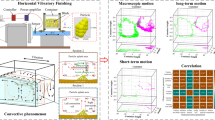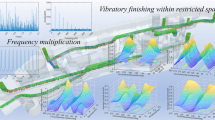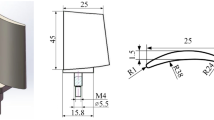Abstract
To analyze the relationship between the movement characteristics of granular media and the particle action behavior, the numerical simulation model of the machining scheme of the blade-combined closed cavity is established based on the discrete element method (DEM). The characteristics of the normal force of oblique triangle particles under collision and scratching motion are analyzed. A method of division of particle action behavior based on the normal force’s duration is proposed. The relationship between the particle movement characteristics of the blade basin and the blade back and the particle action behavior is clarified. The processing experiment and the test force experiment were carried out. The results show that in horizontal vibratory finishing, the particle group at the blade basin produces a periodic movement with a long contact time with the blade basin’s surface under gravity, which is dominated by long-term scratching. Under the shear expansion, the particle group at the blade back produces a periodic movement with a short contact time with the blade back surface, which is dominated by short-term scratching. The cumulative action time of each position on the blade surface is the main factor affecting the uniformity of machining. Compared with the particle group dominated by long-term scratching, the particle group dominated by short-term scratching has more intense movement, higher fluidization degree, and greater force on the workpiece.

















Similar content being viewed by others
Data availability
The datasets supporting the results of this article are included within the article.
References
Sun H, Yan J, Wei X, Chang Z (2020) Digital twin-driven aero-engine assembly technology. China Mech Eng 31:833–841. https://doi.org/10.3969/j.issn.1004-132X.2020.07.009
Huang Y, Xiao G, Zhou L (2016) Current situation and development trend of polishing technology for blisk. Acta Aeronautica ET Astronautica Sinica 37:2045–2064. https://doi.org/10.7527/S1000-6893.2016.0055
Zhang X, Zhu W (2019) Application framework of digital twin-driven product smart manufacturing system: a case study of aeroengine blade manufacturing. Int J Adv Rob Syst 16:172988141988066. https://doi.org/10.1177/1729881419880663
Xiao G, Chen B, Li S, Zhuo X (2022) Fatigue life analysis of aero-engine blades for abrasive belt grinding considering residual stress. Eng Fail Anal 131:105846. https://doi.org/10.1016/j.engfailanal.2021.105846
Yang Y, Zhang Y, Liang Q (2016) Research on application of barrel finishing technology in manufacture of aeroengine. Aeronautical Manufacturing Technology 69–71. https://doi.org/10.16080/j.issn1671-833x.2016.11.069
Li X, Li W, Yang S, Hao Z, Shi H (2018) Study on polyurethane media for mass finishing process: dynamic characteristics and performance. Int J Mech Sci 138–139:250–261. https://doi.org/10.1016/j.ijmecsci.2018.02.017
Yan K (2016) Research on the generation of surface waviness in vibration polishing process for compressor blade. Modern Manuf Eng 104–107. https://doi.org/10.16731/j.cnki.1671-3133.2016.10.021
Lv G, Song Y, Liu J (2011) Analysis and study of polishing method for turbine blade. Turbine Technol 53:239–240. https://doi.org/10.3969/j.issn.1001-5884.2011.03.025
Wang B, He J, Yv J, Pei R, Dai C (2018) Application of high efficiency polishing technology in manufacturing aero-engine components. Diamond & Abrasives Engineering 38:75–80. https://doi.org/10.13394/j.cnki.jgszz.2018.3.0015
Wang X, Yang Q, Song Y, Zhao Z, Tang Z (2017) Surface integrity research of TC17 titanium alloy blade in manufacturing process. Titanium Industry Progress 34:42–46. CNKI:SUN:TGYJ.0.2017-06-012
Wang X, Yang S, Li W, Chen Y, Zhang Q (2017) Experimental investigation of adherent vibratory finishing for sheet specimens. Surface Technol 46, 261–267. https://doi.org/10.16490/j.cnki.issn.1001-3660.2017.10.039
Alcaraz JY, Zhang J, Nagalingam AP, Gopasetty SK, Ton BL, Gopinath A, Ahluwalia K, Ang MGW, Yeo SH (2022) Numerical modeling of residual stresses during vibratory peening of a 3-stage blisk – a multi-scale discrete element and finite element approach. J Mater Process Technol 299:117383. https://doi.org/10.1016/j.jmatprotec.2021.117383
Ciampini D, Papini M, Spelt JK (2007) Impact velocity measurement of media in a vibratory finisher. J Mater Process Technol 183:347–357. https://doi.org/10.1016/j.jmatprotec.2006.10.024
da Silva ML, Spelt JK (2020) Comparison of DEM predictions and measured wall-media contact forces and work in a vibratory finisher. Powder Technol 366:434–447. https://doi.org/10.1016/j.powtec.2020.02.014
Wang X, Yang S, Li W, Wang Y (2018) Vibratory finishing co-simulation based on ADAMS-EDEM with experimental validation. Int J Adv Manuf Technol 96:1175–1185. https://doi.org/10.1007/s00170-018-1639-0
Mediratta R, Ahluwalia K, Yeo SH (2018) Surface motion analysis of double vibro-polishing of Ti-6Al-4 V. Int J Adv Manuf Technol 97:1113–1122. https://doi.org/10.1007/s00170-018-1718-2
Yang S, Qi H, Qin C, Ye S (2021) Optimization of technological parameters for vibration finishing of aluminum-silicon coated blades. Machinery Design & Manufacture 115–119. https://doi.org/10.19356/j.cnki.1001-3997.2021.05.028
Götzendorfer A, Tai C-H, Kruelle CA, Rehberg I, Hsiau SS (2006) Fluidization of a vertically vibrated two-dimensional hard sphere packing: A granular meltdown. Phys Rev E 74:011304. https://doi.org/10.1103/PhysRevE.74.011304
Li L, Wu P, Abdul R, Wang L, Zhang S, Xie Z (2017) Energy-dissipation correlated size separation of granular matter under coupling vibration and airflow. Powder Technol 307:84–89. https://doi.org/10.1016/j.powtec.2016.11.022
Raihane A, Bonnefoy O, Gelet J-L, Chaix J-M, Thomas G (2009) Experimental study of a 3D dry granular medium submitted to horizontal shaking. Powder Technol 190:252–257. https://doi.org/10.1016/j.powtec.2008.04.068
Gallas JAC, Herrmann HJ, Sokołowski S (1992) Convection cells in vibrating granular media. Phys Rev Lett 69:1371–1374. https://doi.org/10.1103/PhysRevLett.69.1371
Pak HK, Behringer RP (1993) Surface waves in vertically vibrated granular materials. Phys Rev Lett 71:1832–1835. https://doi.org/10.1103/PhysRevLett.71.1832
Chen B, Wu P, Xing H, Liu H, Li L, Wang L (2020) Convection behavior of ellipsoidal particles in a quasi-two-dimensional bed under vertical vibration. Powder Technol 363:575–583. https://doi.org/10.1016/j.powtec.2020.01.004
Wu Y, Li X, Wang J, Li W, Yang S, Shi S (2021) Flow field characteristics analysis of media for horizontal vibratory mass finishing. Surface Technology 50:329–338. https://doi.org/10.16490/j.cnki.issn.1001-3660.2021.11.035
Zhang C, Liu W, Wang S, Liu Z, Morgan M, Liu X (2020) Dynamic modeling and trajectory measurement on vibratory finishing. Int J Adv Manuf Technol 106:253–263. https://doi.org/10.1007/s00170-019-04644-8
Kawamoto Y, Kataoka M, Uekusa M, Terumichi Y (2004) Behavior of two kinds of particles in rotary barrel with planetary rotation. Multibody SysDyn 12:187–207. https://doi.org/10.1023/B:MUBO.0000049147.43552.29
Yabuki A, Baghbanan MR, Spelt JK (2002) Contact forces and mechanisms in a vibratory finisher. Wear 252:635–643. https://doi.org/10.1016/S0043-1648(02)00016-9
Hashimoto F, Johnson SP, Chaudhari RG (2016) Modeling of material removal mechanism in vibratory finishing process. CIRP Ann 65:325–328. https://doi.org/10.1016/j.cirp.2016.04.011
Chen Y, Li W, Li X, Wang X (2017) Force test and analysis of abrasive in spindle barrel finishing process. China Surf Eng 30:33–40. https://doi.org/10.11933/j.issn.1007−9289.20160803001
Wang C, Li X, Li W, Wang N, Yang S (2018) Analysis on numerical simulation and mechanism of medium flow field in spindle barrel finishing process. Surf Technol 47:251–258. https://doi.org/10.16490/j.cnki.issn.1001-3660.2018.11.036
Li W, Zhang L, Li X, Yang S, Wu F (2017) Theoretical and simulation analysis of abrasive particles in centrifugal barrel finishing: kinematics mechanism and distribution characteristics. Powder Technol 318:518–527. https://doi.org/10.1016/j.powtec.2017.06.033
Cunha RN, Santos KG, Lima RN, Duarte CR, Barrozo MAS (2016) Repose angle of monoparticles and binary mixture: an experimental and simulation study. Powder Technol 303:203–211. https://doi.org/10.1016/j.powtec.2016.09.023
Rehman A, Wu P, Li L, Zhang S, Wang Li (2016) Convection rolls and individual particles movements in horizontally vibrated granular particles system. Acta Phys Pol A 130:1336–1342. https://doi.org/10.12693/APhysPolA.130.1336
Hao Y, Yang S, Li X, Li W, Wang X (2021) Analysis of contact force characteristics of vibratory finishing within pipe-cavity. Granular Matter 23:32. https://doi.org/10.1007/s10035-021-01089-3
Hashemnia K, Pourandi S (2018) Study the effect of vibration frequency and amplitude on the quality of fluidization of a vibrated granular flow using discrete element method. Powder Technol 327:335–345. https://doi.org/10.1016/j.powtec.2017.12.097
Makiuchi Y, Hashimoto F, Beaucamp A (2019) Model of material removal in vibratory finishing, based on Preston’s law and discrete element method. CIRP Ann 68:365–368. https://doi.org/10.1016/j.cirp.2019.04.082
Hao Z, Li W, Li X, Wu F, Zhao W (2017) Effect of media parameters on contact forces in centrifugal barrel finishing. China Sciencepaper 12:2756–2760. https://doi.org/10.3969/j.issn.2095-2783.2017.23.021
Meng F, Liu H, Hua S, Pang M (2021) Force chain characteristics of dense particles sheared between parallel-plate friction system. Results Phys 25:104328. https://doi.org/10.1016/j.rinp.2021.104328
Sanvitale N, Bowman ET (2016) Using PIV to measure granular temperature in saturated unsteady polydisperse granular flows. Granular Matter 18:57. https://doi.org/10.1007/s10035-016-0620-6
Jalilibal Z, Amiri A, Castagliola P, Khoo MBC (2021) Monitoring the coefficient of variation: a literature review. Comput Indust Eng 161:107600. https://doi.org/10.1016/j.cie.2021.107600
Yang W, Cai L, Wu F (2020) Image segmentation based on gray level and local relative entropy two dimensional histogram. PLoS ONE 15:e0229651. https://doi.org/10.1371/journal.pone.0229651
Zhang Z, Wei H-H, Yum SG, Chen J-H (2019) Automatic object-detection of school building elements in visual data: a gray-level histogram statistical feature-based method. Appl Sci 9:3915. https://doi.org/10.3390/app9183915
Funding
The work was co-supported by the National Natural Science Foundation of China (Grant Nos. 51975399, 51875389, and 52075362).
Author information
Authors and Affiliations
Contributions
Jiaming Wang designed and performed the manuscript, analyzed the data, and drafted the manuscript. Xiuhong Li conceived and supervised the study, and edited the manuscript. Wenhui Li and Shengqiang Yang analyzed the data. All authors read and approved the manuscript.
Corresponding author
Ethics declarations
Ethics approval
Not applicable.
Consent to participate
Not applicable.
Consent for publication
All authors have consent for publication.
Conflict of interest
The authors declare no competing interests.
Additional information
Publisher's Note
Springer Nature remains neutral with regard to jurisdictional claims in published maps and institutional affiliations.
Rights and permissions
Springer Nature or its licensor (e.g. a society or other partner) holds exclusive rights to this article under a publishing agreement with the author(s) or other rightsholder(s); author self-archiving of the accepted manuscript version of this article is solely governed by the terms of such publishing agreement and applicable law.
About this article
Cite this article
Wang, J., Li, X., Li, W. et al. Research of horizontal vibratory finishing for aero-engine blades: movement characteristics and action behavior of media. Int J Adv Manuf Technol 126, 2065–2081 (2023). https://doi.org/10.1007/s00170-023-11186-7
Received:
Accepted:
Published:
Issue Date:
DOI: https://doi.org/10.1007/s00170-023-11186-7




